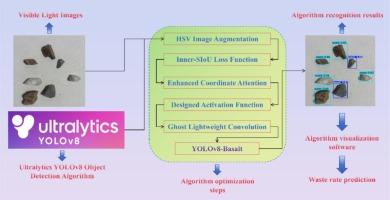Basalt visible light image recognition optimization algorithm based on YOLOv8
IF 5
2区 工程技术
Q1 ENGINEERING, CHEMICAL
引用次数: 0
Abstract
With the rapid advancement of photoelectric intelligent sorting technology, YOLOv8-based algorithms for scheelite recognition have been successfully optimized. However, the development of scheelite resources is often accompanied by substantial waste rock accumulation and tailings discharge, which pose significant environmental challenges. This study focuses on the waste rocks obtained after the pre-concentration stage of scheelite processing. Due to the complex surface features of basalt and its high visual similarity to non-target gangue in visible light images, accurate identification remains difficult. To address this issue, we propose the YOLOv8-Basalt algorithm, which integrates multiple optimization strategies including HSV-based image enhancement, Inner-SIoU loss function, ECA attention mechanism, TSiLU activation function, Optuna-based hyperparameter tuning, and GhostConv lightweight convolution.Ablation and comparative experiments were conducted to evaluate the independent contributions of each module to recognition accuracy and inference efficiency. As a result, the average precision for basalt identification increased from 0.922 to 0.979, and the F1-score improved from 0.90 to 0.93, while maintaining a low inference time of only 2.60 ms. This demonstrates the algorithm’s ability to achieve accurate and rapid recognition of basalt in visible light images.Considering the complexity of deploying YOLO-based models on AI accelerators and their limited compatibility with industrial color sorters, we introduce a simulation-based waste rejection prediction method as an alternative. This approach enables rapid evaluation of sorting performance without relying on specific hardware. Based on quantitative simulation experiments, the predicted waste rejection rate for the test set samples reached 66.46%. The findings of this study provide theoretical support and technical guidance for the industrial deployment of intelligent ore recognition algorithms.

基于YOLOv8的玄武岩可见光图像识别优化算法
随着光电智能分选技术的快速发展,基于yolov8的白钨矿识别算法已被成功优化。然而,白钨矿资源的开发往往伴随着大量的废石堆积和尾矿排放,给环境带来了重大挑战。研究对象为白钨矿选矿预富集阶段后获得的废石。由于玄武岩表面特征复杂,且在可见光图像中与非目标脉石具有很高的视觉相似性,因此对玄武岩进行准确识别仍然存在困难。为了解决这一问题,我们提出了YOLOv8-Basalt算法,该算法集成了多种优化策略,包括基于hsv的图像增强、Inner-SIoU损失函数、ECA注意机制、TSiLU激活函数、基于optuna的超参数调优和GhostConv轻量级卷积。通过消融实验和对比实验来评估每个模块对识别精度和推理效率的独立贡献。结果表明,玄武岩识别的平均精度从0.922提高到0.979,f1分数从0.90提高到0.93,同时保持了较低的推断时间,仅为2.60 ms。这证明了该算法在可见光图像中实现玄武岩准确、快速识别的能力。考虑到在人工智能加速器上部署基于yolo的模型的复杂性以及它们与工业颜色分选机的有限兼容性,我们引入了一种基于仿真的废物排斥预测方法作为替代方案。这种方法可以在不依赖特定硬件的情况下快速评估排序性能。通过定量模拟实验,试验集样品的预测废品率达到66.46%。研究结果为智能矿石识别算法的产业化部署提供了理论支持和技术指导。
本文章由计算机程序翻译,如有差异,请以英文原文为准。
求助全文
约1分钟内获得全文
求助全文
来源期刊

Minerals Engineering
工程技术-工程:化工
CiteScore
8.70
自引率
18.80%
发文量
519
审稿时长
81 days
期刊介绍:
The purpose of the journal is to provide for the rapid publication of topical papers featuring the latest developments in the allied fields of mineral processing and extractive metallurgy. Its wide ranging coverage of research and practical (operating) topics includes physical separation methods, such as comminution, flotation concentration and dewatering, chemical methods such as bio-, hydro-, and electro-metallurgy, analytical techniques, process control, simulation and instrumentation, and mineralogical aspects of processing. Environmental issues, particularly those pertaining to sustainable development, will also be strongly covered.
 求助内容:
求助内容: 应助结果提醒方式:
应助结果提醒方式:


